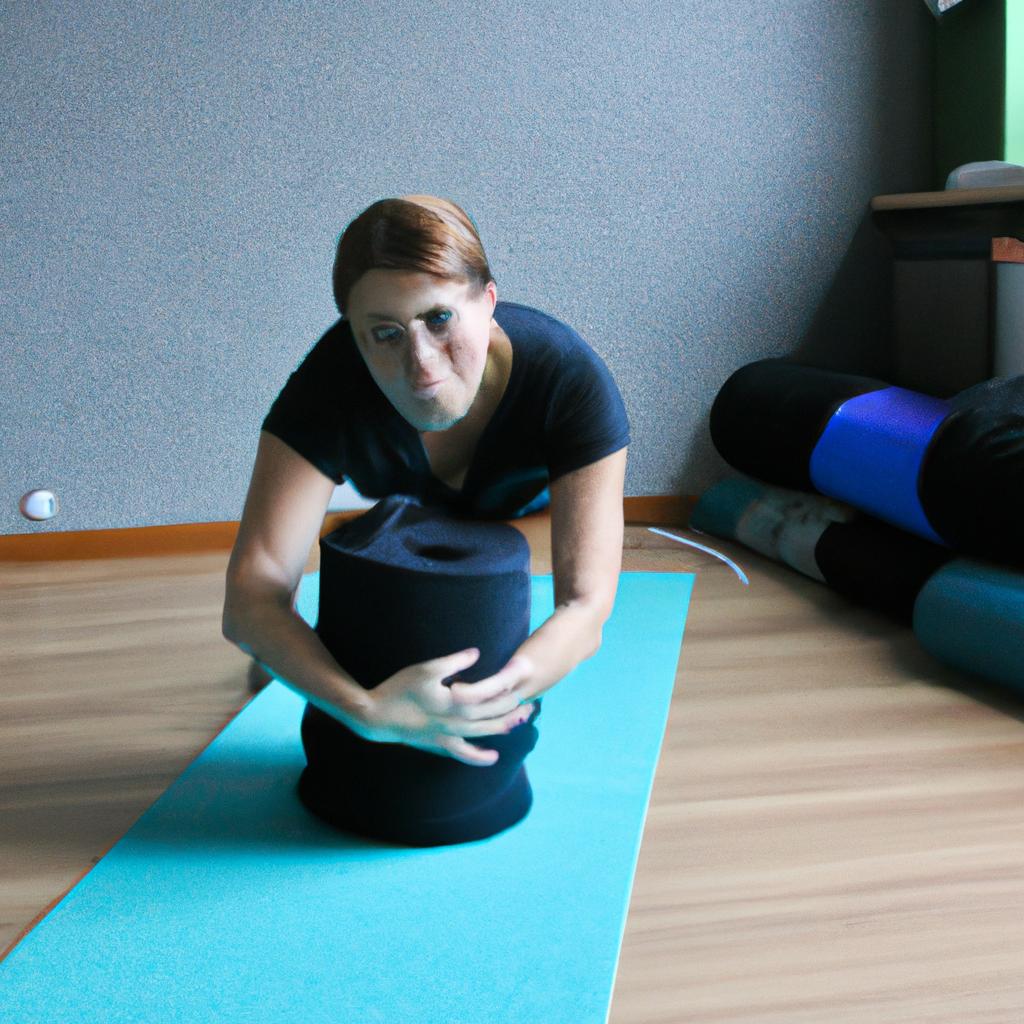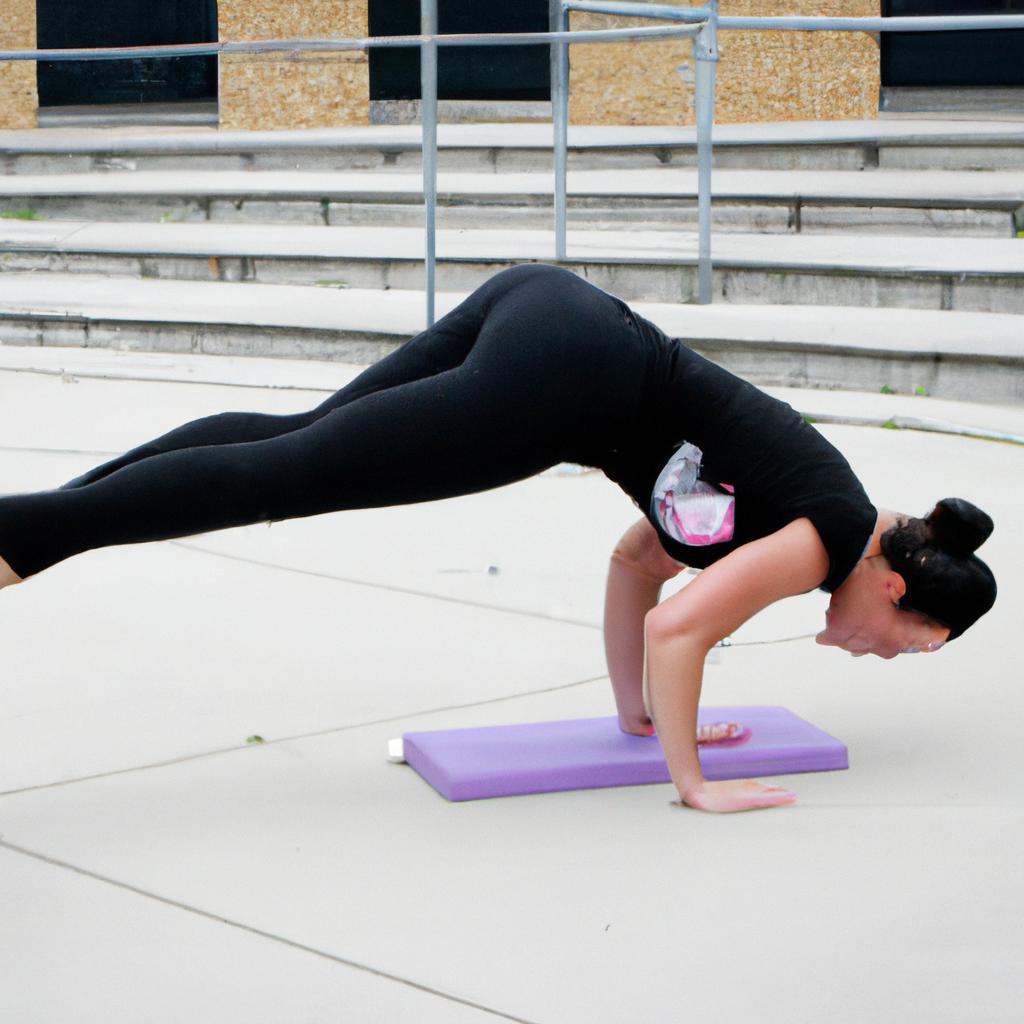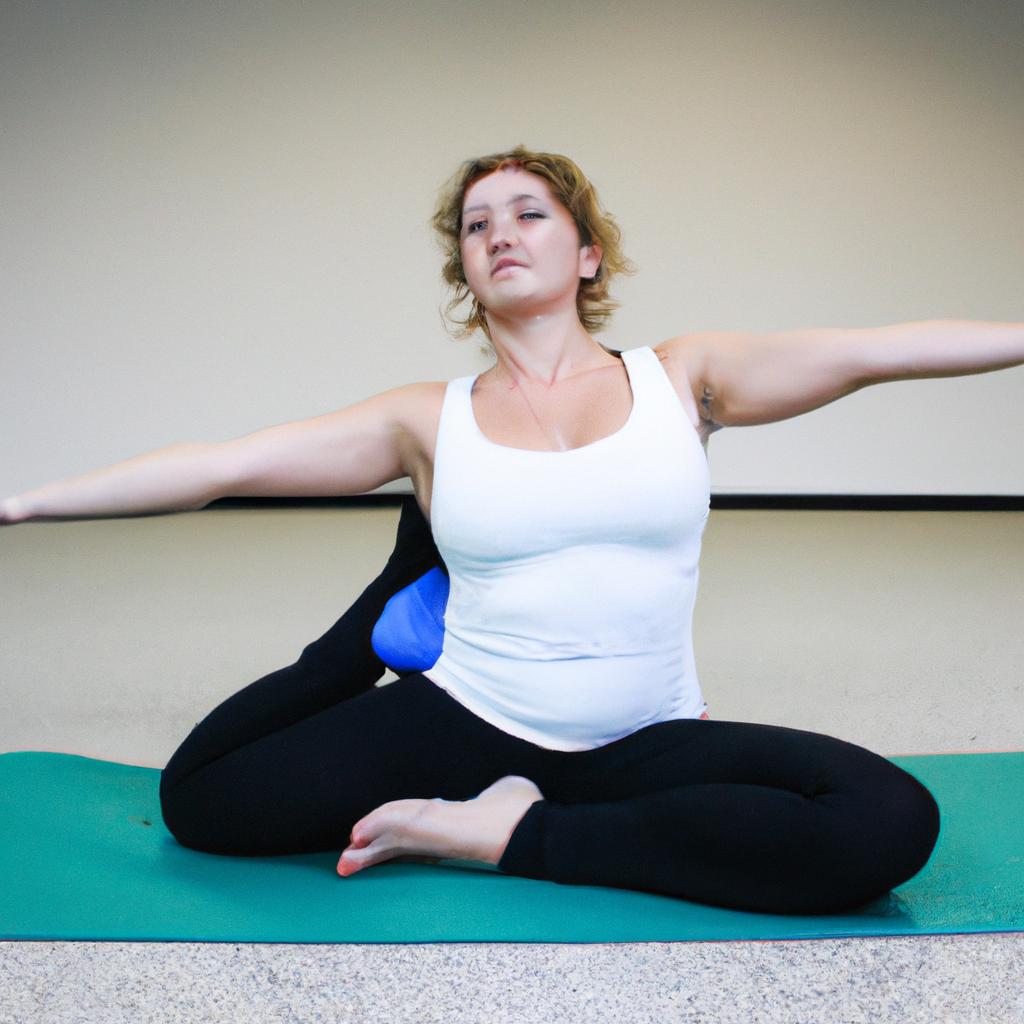Yoga blankets are an essential prop used in the practice of yoga, offering comfort and support to practitioners during their sessions. However, with a wide range of options available in terms of material, size, and texture, selecting the perfect yoga blanket can be a daunting task. In this article, we will explore everything you need to know about choosing the ideal yoga blanket for your practice.
Consider the case of Sarah, a dedicated yogi who recently started attending hot yoga classes at her local studio. As she delved deeper into her practice, Sarah realized that she needed a high-quality yoga blanket that could both absorb sweat and provide cushioning during intense poses. This led her on a quest to find the perfect option among the numerous choices available. Sarah’s experience reflects a common dilemma faced by many individuals seeking a reliable and suitable yoga blanket tailored to their specific needs.
To navigate through this decision-making process successfully, it is crucial to understand various factors such as materials used, dimensions and weight, insulation properties, and durability. By examining these aspects closely and considering personal preferences and requirements aligned with one’s practice style, finding the ideal yoga blanket becomes less overwhelming. Through this comprehensive guide, we aim to equip readers with knowledge and insights necessary for making informed decisions when selecting the perfect yoga blanket.
Materials: When choosing a yoga blanket, consider the materials used. Common options include cotton, wool, acrylic, and fleece. Cotton blankets are lightweight and breathable, making them suitable for all types of yoga practices. Wool blankets provide excellent insulation and moisture-wicking properties, making them ideal for hot yoga or colder environments. Acrylic and fleece blankets offer softness and warmth, but they may not be as breathable as cotton or wool.
Dimensions and Weight: The size of the yoga blanket is an important aspect to consider. Standard dimensions range from 50×60 inches to 60×80 inches. A larger blanket can provide more coverage and versatility in its use, while a smaller one may be easier to carry around. Additionally, consider the weight of the blanket if you plan on bringing it to your yoga classes or using it for travel purposes. Lighter options are more convenient for transportation.
Insulation Properties: If you practice hot yoga or tend to sweat a lot during your sessions, look for a yoga blanket that has good moisture-absorbing properties. Wool blankets excel in this area as they can absorb moisture without feeling damp or heavy. This feature will help keep you dry and comfortable throughout your practice.
Durability: Ensure that the yoga blanket you choose is durable and able to withstand regular use and washing. Look for quality stitching and reinforced edges that prevent fraying over time. Consider reading customer reviews or seeking recommendations from fellow yogis to gauge the durability of different brands or models.
Personal Preferences: Ultimately, personal preferences play a significant role in selecting the right yoga blanket. Do you prefer something soft and cozy? Or do you prioritize breathability? Consider factors such as texture, color options, patterns, and overall aesthetic appeal that align with your taste and style.
By considering these factors along with your specific needs for comfort, support, insulation properties, durability requirements, and personal preferences; you can make an informed decision when selecting the perfect yoga blanket for your practice.
How to Choose the Right Size of Yoga Blanket
Imagine you are a yoga practitioner who has just started attending classes regularly. You have recently discovered the benefits of using a yoga blanket to support your practice and enhance your overall experience. However, as you browse through various options online or in stores, you find yourself faced with the question: “What size should my yoga blanket be?” This article aims to shed light on this crucial aspect of selecting the perfect yoga blanket.
To start, it is important to consider your body type and personal preferences when choosing the right size of yoga blanket. A general rule of thumb is that the blanket should be large enough to cover your entire body comfortably during restorative poses such as Savasana (Corpse Pose) or Balasana (Child’s Pose). Additionally, if you plan on incorporating props like bolsters or blocks into your practice, ensure that the dimensions of your chosen blanket allow for their effective use alongside it.
When determining the appropriate size, keep in mind that different styles of yoga may require varying amounts of coverage and support. For instance, if you primarily practice Yin or Restorative yoga, where long holds in seated or supine positions are common, opting for a larger-sized blanket might provide added comfort and stability. On the other hand, if you prefer more dynamic practices like Vinyasa or Power yoga, a smaller-sized blanket could offer greater versatility and ease of movement.
Consider these factors when deciding which size best suits your needs:
- Body proportions: Take into account both height and width measurements to ensure adequate coverage.
- Intended usage: Determine whether you will mainly use the blanket for relaxation purposes or also incorporate it into active poses.
- Transportability: If you plan on bringing your own yoga mat and accessories with you to class or while traveling, consider how easily a certain size can fit within your bag without adding unnecessary bulk.
- Budget constraints: Larger-sized blankets often come at a higher cost, so assess your financial limitations before making a final decision.
To summarize, choosing the right size of yoga blanket involves considering personal factors such as body type, preferred style of practice, and intended usage. By taking these aspects into account along with practical considerations like transportability and budget constraints, you can make an informed decision that enhances your yoga journey.
Different Types of Yoga Blanket Materials
Now that we have discussed the importance of choosing the right size for your yoga blanket, let’s explore the different types of materials available. Selecting the appropriate material is crucial as it can greatly impact your yoga practice and overall comfort.
When it comes to yoga blankets, there are various options in terms of materials. One popular choice is cotton, known for its softness and breathability. Cotton blankets provide a gentle touch against your skin and allow for easy absorption of sweat during intense yoga sessions. Additionally, they offer sufficient warmth without causing overheating. For instance, imagine practicing hot yoga with a cotton blanket that keeps you cool and comfortable throughout your session.
In contrast, wool blankets are favored by many yogis due to their excellent insulation properties. Wool has natural temperature-regulating qualities, which means it will keep you warm during colder practices while still allowing ventilation when needed. Moreover, wool blankets have a luxurious feel and durability that make them long-lasting companions on your yoga journey.
To help simplify the decision-making process when selecting a yoga blanket material, here are some key factors to consider:
- Texture: Determine whether you prefer a smooth or textured surface based on personal preference and how it feels against your skin.
- Weight: Consider the weight of the blanket – lighter ones may be suitable for restorative practices while heavier ones provide more stability during dynamic movements.
- Maintenance: Assess the level of maintenance required for each material; some may require special care instructions such as hand-washing or dry-cleaning.
- Sustainability: Explore eco-friendly options like organic cotton or sustainably sourced wool to align your purchase with environmental values.
Now that we have explored different materials used in yoga blankets and considered important factors to guide our selection process, let us delve deeper into other aspects to consider when choosing the perfect yoga blanket for your practice.
Factors to Consider When Selecting a Yoga Blanket
Imagine you are a dedicated yogi, seeking the perfect yoga blanket to enhance your practice. You carefully consider various factors to ensure that it aligns with both your personal preferences and practical requirements. One essential aspect to ponder is the choice of materials used in manufacturing yoga blankets.
When exploring different types of yoga blanket materials, one common option is cotton. Known for its softness and breathability, cotton provides comfort during your practice while allowing air circulation to prevent overheating. Another popular material is wool, which offers excellent insulation and warmth, making it suitable for cooler environments or restorative practices where keeping the body cozy is crucial.
Additionally, synthetic blends like polyester and acrylic have gained popularity due to their durability and affordability. These materials often offer moisture-wicking properties, ensuring that sweat does not accumulate on the surface of the blanket during an intense session. However, some individuals prefer natural fibers over synthetics due to environmental concerns or skin sensitivities.
Consider these key points when choosing a yoga blanket material:
- Comfort: Opt for a material that feels pleasant against your skin and promotes relaxation.
- Durability: Ensure that the chosen fabric can withstand regular use without losing its quality.
- Breathability: Select a material that allows proper airflow to avoid discomfort caused by excessive heat retention.
- Sustainability: If environmental impact matters to you, choose eco-friendly options made from organic or recycled materials.
To further aid your decision-making process, let’s examine a comparison table showcasing different characteristics of commonly used yoga blanket materials:
| Material | Comfort Level | Durability | Breathability |
|---|---|---|---|
| Cotton | High | Moderate | High |
| Wool | Moderate | High | Low |
| Polyester | Moderate | High | High |
This table highlights how each material varies in comfort level, durability, and breathability. Remember that the perfect yoga blanket material depends on your personal needs and preferences.
Transitioning into the next section about “The Importance of Breathability in Yoga Blankets,” it becomes evident that the right choice of materials plays a vital role in ensuring optimal air circulation during your practice. By understanding how different fabrics perform regarding breathability, you can make an informed decision when selecting your ideal yoga blanket.
The Importance of Breathability in Yoga Blankets
Having considered the important factors to keep in mind when selecting a yoga blanket, let us now delve into another essential aspect: the importance of breathability in yoga blankets.
Breathability is a crucial characteristic that can greatly enhance your yoga practice. Imagine yourself engaging in an intense Vinyasa flow, moving dynamically from one pose to another. As your body temperature rises and you begin to perspire, you would want a yoga blanket that allows air circulation and moisture-wicking properties to keep you cool and comfortable throughout your practice.
To better understand the significance of breathability, consider this hypothetical scenario: You are attending a hot yoga class where the room temperature reaches 105°F (40.6°C). Without a breathable yoga blanket, excessive heat could become trapped between your body and the fabric, leading to discomfort and potentially hindering your ability to fully reap the benefits of each posture.
When searching for a highly breathable yoga blanket, here are some key features to look out for:
- Moisture-wicking fabrics such as bamboo or microfiber
- Open-weave designs that promote airflow
- Lightweight materials that prevent overheating
- Quick-drying capabilities for easy maintenance
By opting for a yoga blanket with these characteristics, you can ensure optimal breathability during your practice, allowing you to focus on connecting with your breath and achieving inner tranquility.
Consider how incorporating a breathable yoga blanket into your practice can evoke positive emotions:
- Enhanced comfort leads to deeper relaxation.
- Improved airflow promotes mental clarity.
- Reduced sweating increases confidence during challenging poses.
- A sense of freshness fosters overall well-being.
Table: Benefits of Choosing a Breathable Yoga Blanket
| Benefit | Description |
|---|---|
| Increased Comfort | Breathable fabrics provide enhanced cushioning and softness. |
| Improved Focus | Proper airflow supports a clear and focused mind. |
| Enhanced Confidence | Reduced sweating helps maintain composure during practice. |
| Overall Well-being | The freshness from breathability contributes to a sense of well-being. |
Incorporating a breathable yoga blanket into your practice can have numerous benefits that extend beyond physical comfort. By choosing a blanket with moisture-wicking properties, open-weave designs, lightweight materials, and quick-drying capabilities, you can ensure optimal breathability throughout your yoga sessions.
With the importance of breathability in mind, let us now explore how to clean and maintain your yoga blanket effectively without compromising its quality or functionality.
How to Clean and Maintain Your Yoga Blanket
The Importance of Choosing the Right Size Yoga Blanket
Imagine this scenario: you walk into a yoga studio for your first class, excited to start your practice. As you unroll your mat and get ready, you realize that the blanket provided by the studio is too small to cover your entire body during relaxation poses. This lack of coverage can be distracting and hinder your ability to fully relax and let go.
When it comes to choosing the perfect yoga blanket, size matters. The right size will provide adequate coverage and support for various postures, allowing you to focus on your breath and movement without any discomfort or distractions. Consider these key factors when selecting the size of your yoga blanket:
-
Body Coverage: Opt for a blanket that is large enough to comfortably cover your entire body from head to toe. This ensures that all parts of your body receive equal warmth and support during relaxation poses like Savasana.
-
Versatility: Choose a blanket that is versatile in its usage. It should be wide enough to fold over as padding under sensitive joints such as knees or elbows, but also lightweight enough to use as a shawl during seated meditation practices.
-
Portability: If you plan on carrying your yoga blanket with you to classes or retreats, consider its weight and portability. A heavy or bulky blanket may become inconvenient while traveling, so finding a balance between comfort and convenience is essential.
-
Personal Preference: Ultimately, choose a size that aligns with your personal preference and needs. Some practitioners may prefer larger blankets for added cushioning and warmth, while others may prefer smaller ones for more control over their practice.
To illustrate how different sizes can impact one’s practice experience further, here is an example table showcasing three common sizes of yoga blankets along with their potential benefits:
| Size | Benefits |
|---|---|
| Small | – Easy to carry around- Ideal for targeted support on specific body parts |
| Medium | – Versatile usage for various poses- Sufficient coverage during relaxation and as padding |
| Large | – Maximum coverage and warmth- Suitable for tall individuals or those who prefer more cushioning |
In conclusion, selecting the right size yoga blanket is crucial in enhancing your practice. It ensures adequate coverage, versatility, portability, and aligns with personal preferences. Now that you understand the importance of choosing the perfect size, let’s explore tips for finding the best deals on yoga blankets.
Tips for Finding the Best Deals on Yoga Blankets
Now, let’s delve into some helpful tips for finding the best deals on these essential yoga accessories.
Imagine this scenario: Sarah is a dedicated yogi who practices regularly at her local studio. She loves using a cozy and high-quality yoga blanket during her practice but doesn’t want to break the bank. Here are some strategies that can help Sarah, and others like her, find affordable yet durable yoga blankets:
- Compare prices: Start by researching different brands and retailers to compare prices. Don’t forget to look online as well, where you may find better deals or discounts.
- Consider second-hand options: Check out thrift stores or online platforms where individuals sell used items. You might be surprised at the quality of gently-used yoga blankets available at a fraction of their original cost.
- Subscribe to newsletters: Sign up for newsletters from your favorite brands or retailers. Often, they offer exclusive discounts or promotions to subscribers.
- Wait for seasonal sales: Keep an eye out for major shopping events such as Black Friday or end-of-season sales when many retailers offer significant markdowns on various products.
To further illustrate these tips, consider the following comparison table showcasing three popular brands of yoga blankets along with their respective prices and features:
| Brand | Price ($) | Features |
|---|---|---|
| Brand A | 40 | Organic cotton, extra-large size |
| Brand B | 30 | Recycled polyester blend, lightweight |
| Brand C | 25 | Microfiber fabric, moisture-wicking properties |
This table not only provides valuable information about different options available in terms of price range and features but also helps potential buyers make an informed decision based on individual preferences.
By employing these savvy techniques and considering the various options available, yoga enthusiasts like Sarah can find high-quality yet affordable yoga blankets to enhance their practice without straining their budgets.
Remember, finding the perfect yoga blanket doesn’t have to be a daunting task. With a little research and patience, you can discover great deals that align with your needs and budget. So go ahead and explore these tips to find the ideal companion for your yoga journey.
 Buzzez
Buzzez



